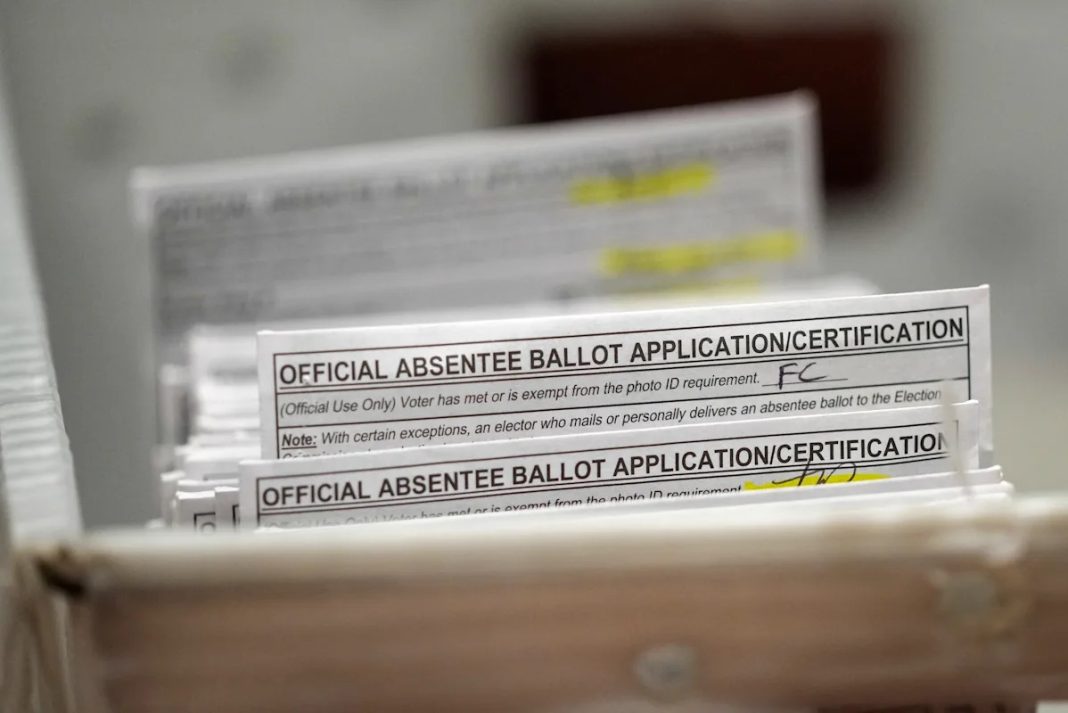President Trump on Monday said he would lead a movement to get rid of mail-in voting, based on the false claim that they lead to widespread fraud.
“ELECTIONS CAN NEVER BE HONEST WITH MAIL IN BALLOTS/VOTING,” he wrote in a post on Truth Social in which he also railed against voting machines used across the country.
Trump wrote that he would be signing an executive order to “to help bring HONESTY” to next year’s midterm elections, but didn’t share any details on what that order might include or what legal authority he would rely on to issue it. The Constitution gives states the power to control their own elections within the confines of laws set out by Congress. The president does not have the ability to unilaterally change voting laws.
Trump has a long history of opposition to mail-in voting, also known as absentee voting.
False claims about mail ballots being rife with fraud are central to his unfounded belief that the 2020 presidential election was rigged against him.
“We gotta stop mail-in voting and the Republicans have to lead the charge,” Trump told reporters at the White House Monday. “If you [end] mail in voting, you’re not gonna have many Democrats get elected.”
It is true that Democrats voted by mail in much larger numbers than Republicans during the 2020 election, but that discrepancy was largely attributable to the unique circumstances of the COVID pandemic, along with Trump’s persistent criticism of the practice in the months before Election Day. Historically, mail ballots have not given either party a strong partisan advantage. The GOP also closed, or in some states even flipped, the mail-in voting gap during last year’s presidential race.
Trump’s renewed focus on mail-in voting seemed to come after his conversation with Russian President Vladimir Putin during their summit in Alaska last week to discuss a potential end to the war in Ukraine.
“Vladimir Putin, smart guy, said you can’t have an honest election with mail-in voting,” he told Fox News host Sean Hannity in his first interview after the summit.
During the Fox News interview, he also falsely claimed that the U.S. is “the only country in the world” that allows mail-in voting because it’s so rife with fraud. In fact, dozens of countries permit at least some voters to cast their ballots through the mail.
Growing importance
There has been limited use of absentee ballots since the earliest days of the United States, but the practice has become much more common in recent decades. The share of ballots cast by mail during presidential election years doubled between 2000 and 2016, reaching 21% during Trump’s first successful presidential run, according to the U.S. Census Bureau. Four years later, concerns about COVID infection and more permissive absentee ballot rules caused the use of mail-in voting to spike dramatically. More than 40% of ballots cast in the 2020 race were sent through the mail. Mail-in voting declined to 29% of all ballots last year, but that was still well above any previous non-pandemic year on record.
Every state allows mail-in voting to a certain extent, but access to absentee ballots varies a lot. Some states require anyone who wants to vote by mail to provide a valid excuse for why they’re unable to cast their ballot in person. About two dozen states allow anyone to apply for a mail-in ballot without providing a reason. A handful of states conduct what are known as “all-mail” elections, where people can still vote in person if they choose, but ballots are automatically sent to all registered voters.
States can also have very different rules for when absentee ballots must be requested, when they must be received and when they can be counted.
Fraud in American elections is exceedingly rare, regardless of how votes are cast. Experts have found that mail-in ballots do have a slightly elevated rate of fraud compared to in-person voting, but the overall numbers are far too low to have had a meaningful effect on any election, let alone a presidential race in which more than 150 million ballots are cast.
A database of known electoral fraud incidents compiled by the staunchly conservative Heritage Foundation found just 378 cases of mail-in voting fraud in the U.S. since 1982, a time period in which more than 1.2 billion votes were cast in presidential elections alone.
GOP attitudes shifting
Trump’s opinion of mail-in voting hasn’t changed, but that’s not the case with members of his party. Republican voters have almost completely flipped their views on the practice over the past few years. Less than one in five GOP voters said they were confident that mail-in ballots were counted accurately in the wake of Trump’s loss in 2020, according to the Pew Research Center. After his victory last year, however, 72% of Republicans said they had faith that mail-in votes were fairly counted. Confidence among Democrats also shifted, dropping from 95% in 2020 to 78% last year.
It remains to be seen what will happen to public opinion in the wake of Trump’s new attacks on mail-in voting. It’s also unclear how much, if at all, he might be able to limit access to absentee ballots through executive action. Any steps he does attempt to take will likely face an immediate legal challenge.

